An Eco-Friendly Gas Insulated Transformer Design
Abstract
:1. Introduction
2. Materials and Methods
2.1. Breakdown Voltage Test
2.1.1. Experimental Setup and Procedure
2.1.2. Theoretical Calculation
2.2. R410A Insulation GITs Analysis
2.2.1. Experimental Setup
2.2.2. Simulation of R410A GIT Model
2.2.3. Electrostatic Analysis
2.2.4. Analysis of Distribution of Lightning Impulse Voltage
2.2.5. Thermal Analysis of 50 kVA Distribution Transformer
3. Conclusions
- (1)
- The pure R410A dielectric strength nearly 0.78 times of SF6 under non-ideal conditions. The insulation strength of R410A can reach more than 96% of SF6 with buffer gases. In this case, attention should also be paid to the GWP values.
- (2)
- The AC breakdown voltages of R410A increase linearly by increasing the gap length. The proposed gas demonstrates good dielectric properties.
- (3)
- Both electrostatic analysis and lightning impulse voltage analysis results show that the tank pressure for SF6 and R410A is nearly 3 atm.
- (4)
- Temperature distribution (hot points) inside the tank was found respectively 62.69 °C, 69 °C, 72.06 °C for oil, SF6 and R410A. From these outcomes, it can be deduced that, the use of R410A has nearly same potential over SF6 and transformer oil.
- (5)
- Furthermore, these mixture gasses are cost-effective, eco-friendly and reduce the amount of GWP nearly 90% as compared to pure SF6.
Author Contributions
Funding
Acknowledgments
Conflicts of Interest
References
- Doukas, H.; Karakosta, C.; Flamos, A.; Psarras, J. Electric power transmission: An overview of associated burdens. Int. J. Energy Res. 2010, 35, 979–988. [Google Scholar] [CrossRef]
- Fofana, I. 50 years in the development of insulating liquids. IEEE Electr. Insul. Mag. 2013, 29, 13–25. [Google Scholar] [CrossRef]
- Panwar, N.L.; Kaushik, S.C.; Kothari, S. Role of renewable energy sources in environmental protection: A review. Renew. Sustain. Energy Rev. 2011, 15, 1513–1524. [Google Scholar] [CrossRef]
- Toda, K. Structural features of gas insulated transformers. In Proceedings of the IEEE/PES Transmission and Distribution Conference and Exhibition, Institute of Electrical and Electronics Engineers, Dallas, TX, USA, 7–12 September 2003; IEEE: Dallas, TX, USA, 2003; Volume I, pp. 508–510. [Google Scholar]
- Bolotinha, M. Gas-insulated transformer. Transformers Magazine, January 2018. [Google Scholar]
- Eves, M.; Kilpatrick, D.; Edwards, P.; Berry, J. A Literature Review on SF6 Gas Alternatives for Use on The Distribution Network; Western Power Distribution: Wales, UK, 2018; pp. 6–39. [Google Scholar]
- Li, Y.; Zhang, X.; Zhang, J.; Xiao, S.; Xie, B.; Chen, D.; Tang, J. Assessment on the toxicity and application risk of C4F7N: A new SF6 alternative gas. J. Hazard. Mater. 2019, 368, 653–660. [Google Scholar] [CrossRef] [PubMed]
- Kieffel, Y.; Irwin, T.; Ponchon, P. Green gas to replace SF6 in electrical grids. IEEE Power Energy Mag. 2016, 14, 32–39. [Google Scholar] [CrossRef]
- Kyoto Protocol to The United Nations Framework Convention on Climate Change, United Nations, Kyoto, Japan. 1998. Available online: https://www.gegridsolutions.com/hvmv_equipment/catalog/g3/ (accessed on 9 March 2021).
- Xiao, A.; Owens, J.G.; Bonk, J.; Zhang, A.; Wang, C.; Tu, Y. Environmentally friendly insulating gases as SF6 alternatives for power utilities. In Proceedings of the 2nd International Conference on Electrical Materials and Power Equipment (ICEMPE), Guangzhou, China, 7–10 April 2019; pp. 42–48. [Google Scholar]
- Polvani, L.M.; Abalos, M.; Garcia, R.; Kinnison, D.; Randel, W.J. Significant weakening of Brewer-Dobson circulation trends over the 21st century as a consequence of the Montreal Protocol. Geophys. Res. Lett. 2018, 45, 401–409. [Google Scholar] [CrossRef] [Green Version]
- Gas Insulated Transformer Market by Type, Voltage, Installition, End-User, and Region-Global Forecast to 2023, Markets and Markets. 2018. Available online: https://www.marketsandmarkets.com/Market-Reports/gas-insulated-transformer-market-175735946.html (accessed on 9 March 2021).
- Ullah, R.; Ullah, Z.; Haider, A.; Amin, S.; Khan, F. Dielectric properties of tetrafluoroethane (R134) gas and its mixtures with N2 and air as a sustainable alternative to SF6 in high voltage applications. Electr. Power Syst. Res. 2018, 163, 532–537. [Google Scholar] [CrossRef]
- Xiao, S.; Zhang, X.; Tang, J.; Liu, S. A review on SF6 substitute gases and research status of CF3I gases. Energy Rep. 2018, 4, 486–496. [Google Scholar] [CrossRef]
- Kieffel, Y.; Biquez, F.; Ponchon, P. Alternative gas to SF6 for use in high voltage switchgears: G3. CIRED Pap. 2015, 230. [Google Scholar]
- Xiao, D. Development Prospect of Gas Insulation Based on Environmental Protection. In Simulation and Modelling of Electrical Insulation Weaknesses in Electrical Equipment; IntechOpen: London, UK, 2018; pp. 79–102. [Google Scholar]
- Wang, Y.; Huang, D.; Liu, J.; Zhang, Y.; Zeng, L. Alternative environmentally friendly insulating gases for SF6. Processes 2019, 7, 216. [Google Scholar] [CrossRef] [Green Version]
- Khan, B.; Saleem, J.; Khan, F.; Faraz, G.; Ahmad, R.; Ur Rehman, N.; Ahmad, Z. Analysis of the dielectric properties of R410A Gas as an alternative to SF6 for high-voltage applications. High Volt. 2019, 4, 41–48. [Google Scholar] [CrossRef]
- Beroual, A.; Haddad, A.M. Recent advances in the quest for a new insulation gas with a low impact on the environment to replace sulfur hexafluoride (SF6) gas in high-voltage power network applications. Energies 2017, 10, 1216. [Google Scholar] [CrossRef] [Green Version]
- Kharal, H.S.; Kamran, M.; Ullah, R.; Saleem, M.Z.; Alvi, M.J. Environment-Friendly and Efficient Gaseous Insulator as a Potential Alternative to SF6. Processes 2019, 7, 740. [Google Scholar] [CrossRef] [Green Version]
- Koch, D. SF6 properties, and use in MV and HV switchgear. Cah. Tech. 2003, 188. [Google Scholar]
- Honeywell Refrigerants, Genetron® AZ-20 (R-410A) Brochure. Available online: https://www.honeywell-refrigerants.com/europe/product/genetron-az-20/ (accessed on 9 June 2021).
- Mitra, B. Supercritical Gas Cooling and Condensation of Refrigerant R410A at Near-Critical Pressures. Ph.D. Thesis, Georgia Institute of Technology, Atlanta, GA, USA, 2005. [Google Scholar]
- Zeng, F.; Tang, J.; Fan, Q.; Pan, J.; Zhang, X.; Yao, Q.; He, J. Decomposition characteristics of SF6 under thermal fault for temperatures below 400 C. IEEE Trans. Dielectr. Electr. Insul. 2014, 21, 995–1004. [Google Scholar] [CrossRef]
- Geller, V.Z.; Nemzer, B.V.; Cheremnykh, U.V. Thermal conductivity of the refrigerant mixtures R404A, R407C, R410A, and R507A. Int. J. Thermophys. 2001, 22, 1035–1043. [Google Scholar] [CrossRef]
- Luwen, X. Occupational hazards of sulphur hexafluoride in power system. China Occup. Med. 2004, 31, 66–67. [Google Scholar]
- R-410A Refrigerant Market Share 2021 Global Gross Margin Analysis, Industry Leading Players Update, Development History, Business Prospect and Industry Research Report 2025. The Cowboy Channel. Available online: https://www.thecowboychannel.com/story/43064881/r-410a-refrigerant-market-share-2021-global-gross-margin-analysis-industry-leading-players-update-development-history-business-prospect-and-industry (accessed on 9 March 2021).
- Lemke, E.; Berlijn, S.; Gulski, E. Guide for electrical partial discharge measurements in compliance to IEC 60270. Electra 2008, 241, 60–68. [Google Scholar]
- Berzak, L.F.; Dorfman, S.E.; Smith, S.P. Paschen′s Law in Air and Noble Gases. Available online: http://www-eng.lbl.gov/~shuman/XENON/REFERENCES&OTHER_MISC/paschen_report.pdf (accessed on 9 March 2021).
- Loveless, A.M. A New Universal Gas Breakdown Theory for Classical Length Scales. Ph.D. Thesis, Purdue University, West Lafayette, IN, USA, 2017. [Google Scholar]
- Ghaleb, F.; Belasri, A. Numerical and theoretical calculation of breakdown voltage in the electrical discharge for rare gases. Radiat. Eff. Defects Solids 2012, 167, 377–383. [Google Scholar] [CrossRef]
- Donaldson, A.L. Electrode Erosion Measurements in a High Energy Spark Gap. Ph.D. Thesis, Texas Tech University, Lubbock, TX, USA, 1982. [Google Scholar]
- Özgönenel, O.; Thomas, D.; Kurt, Ü. SF6 gas-insulated 50-kVA distribution transformer design. Turk. J. Electr. Eng. Comput. Sci. 2018, 26, 2140–2150. [Google Scholar] [CrossRef]
- Hartwig, A.; MAK Commission. White mineral oil, pharmaceutical. In The MAK-Collection for Occupational Health and Safety: Annual Thresholds and Classifications for the Workplace; Wiley-VCH Verlag GmbH & Co. KGaA: Weinheim, Germany, 2015; Volume 2, pp. 1177–1191. [Google Scholar]
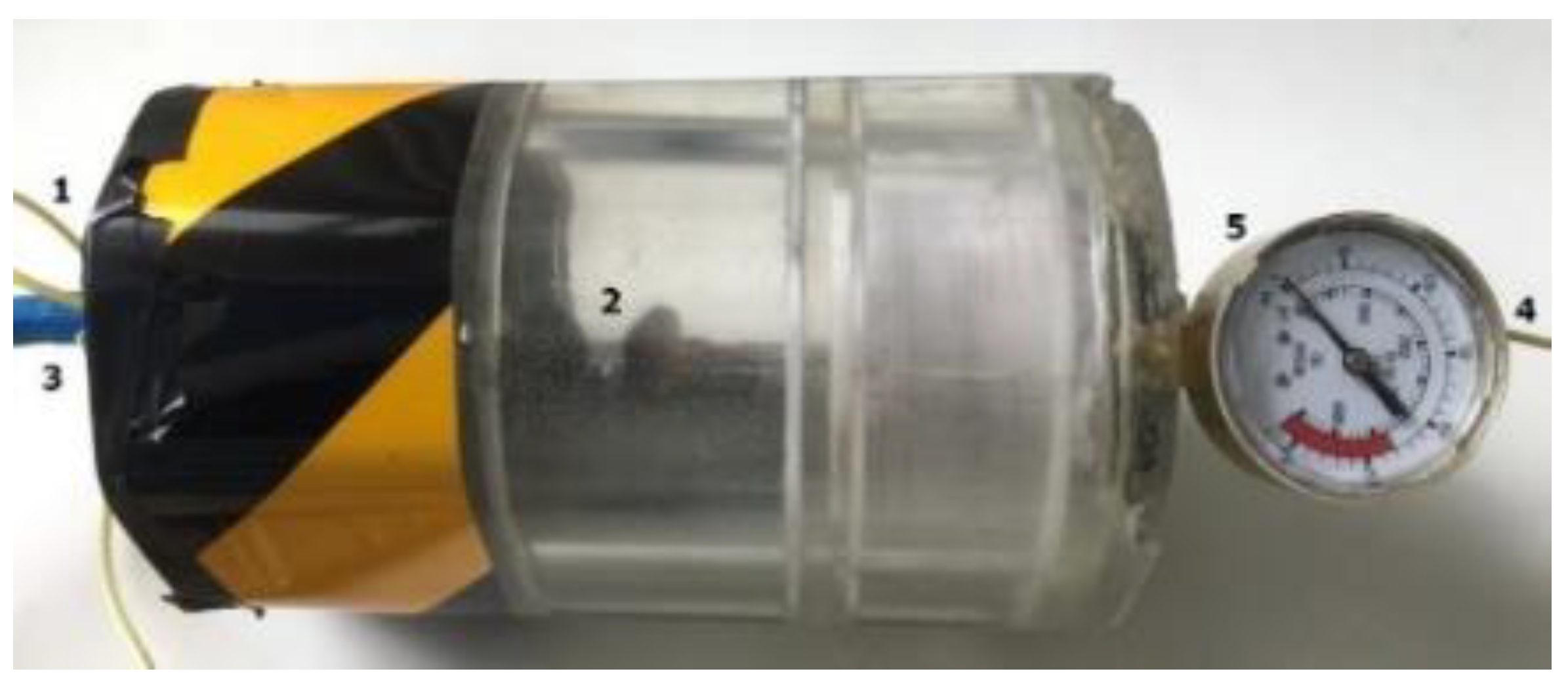
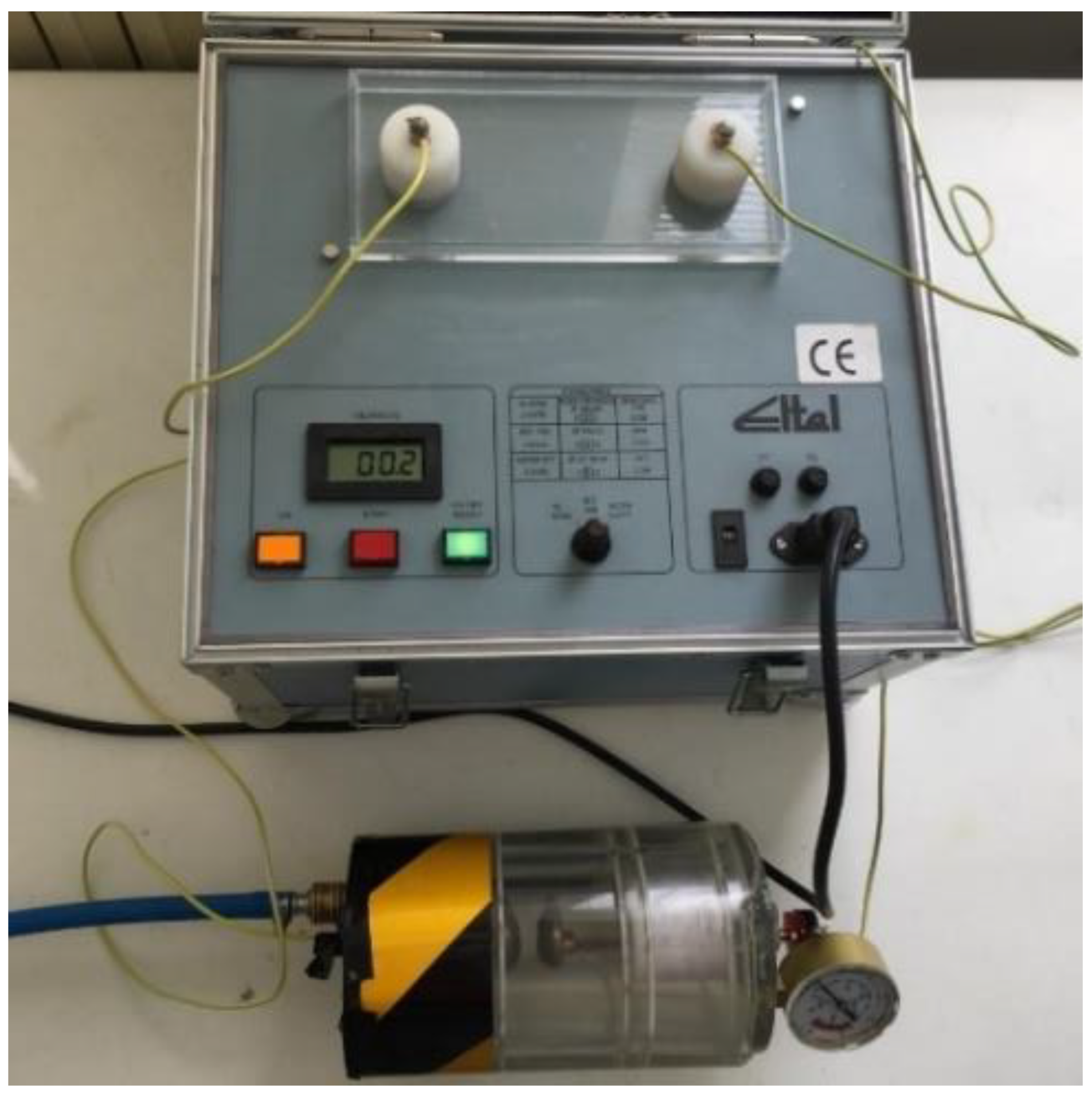
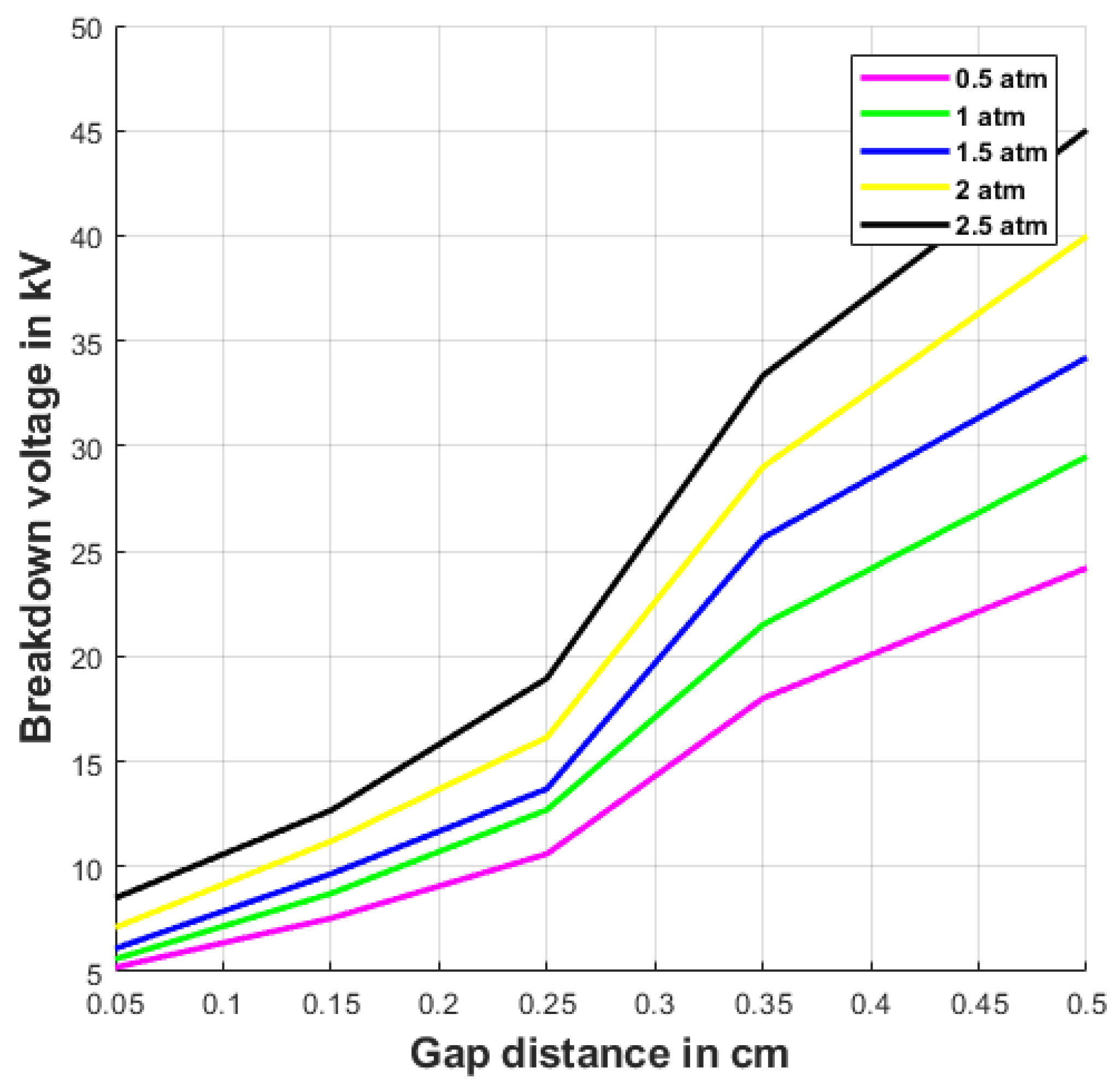
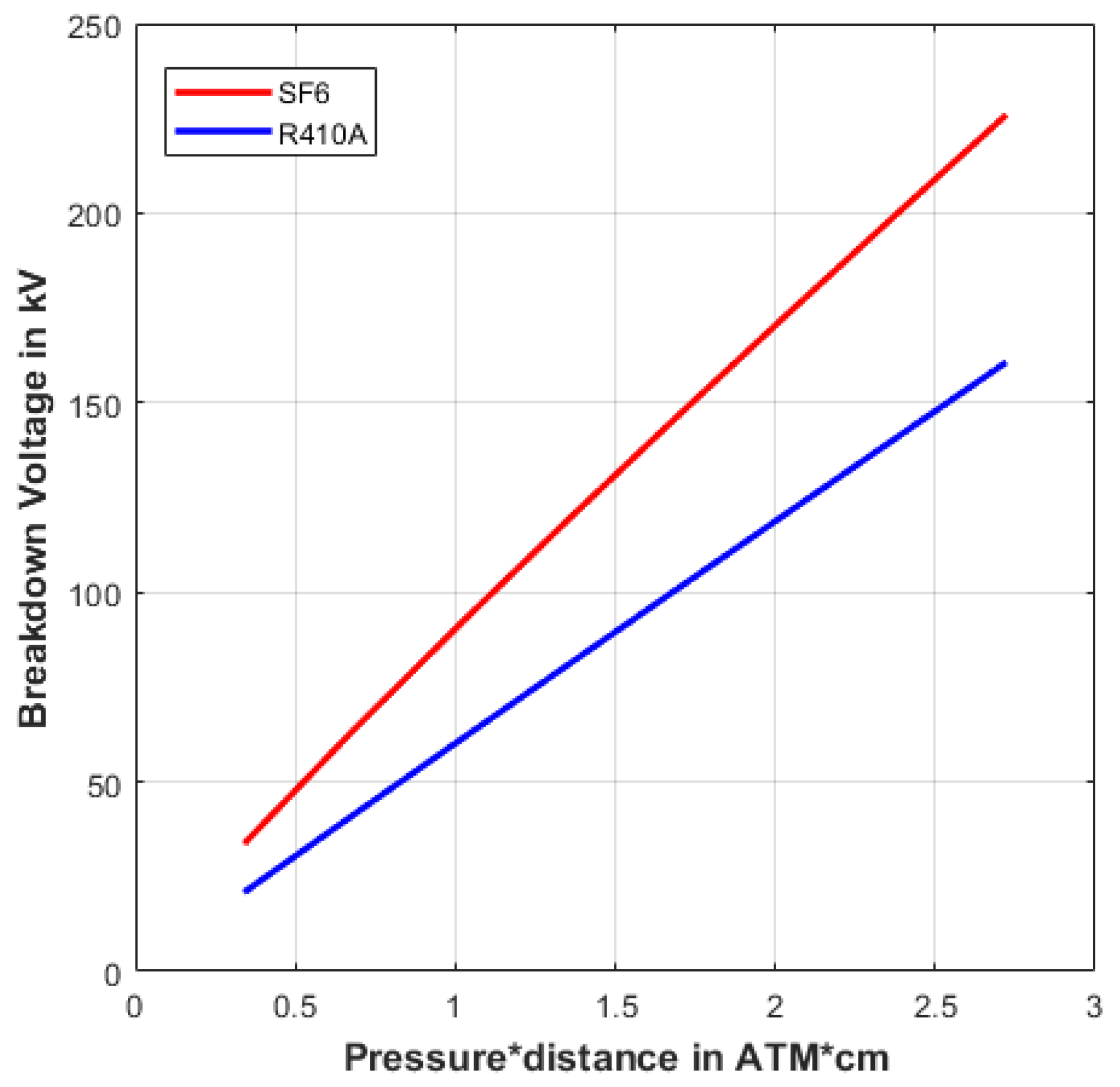
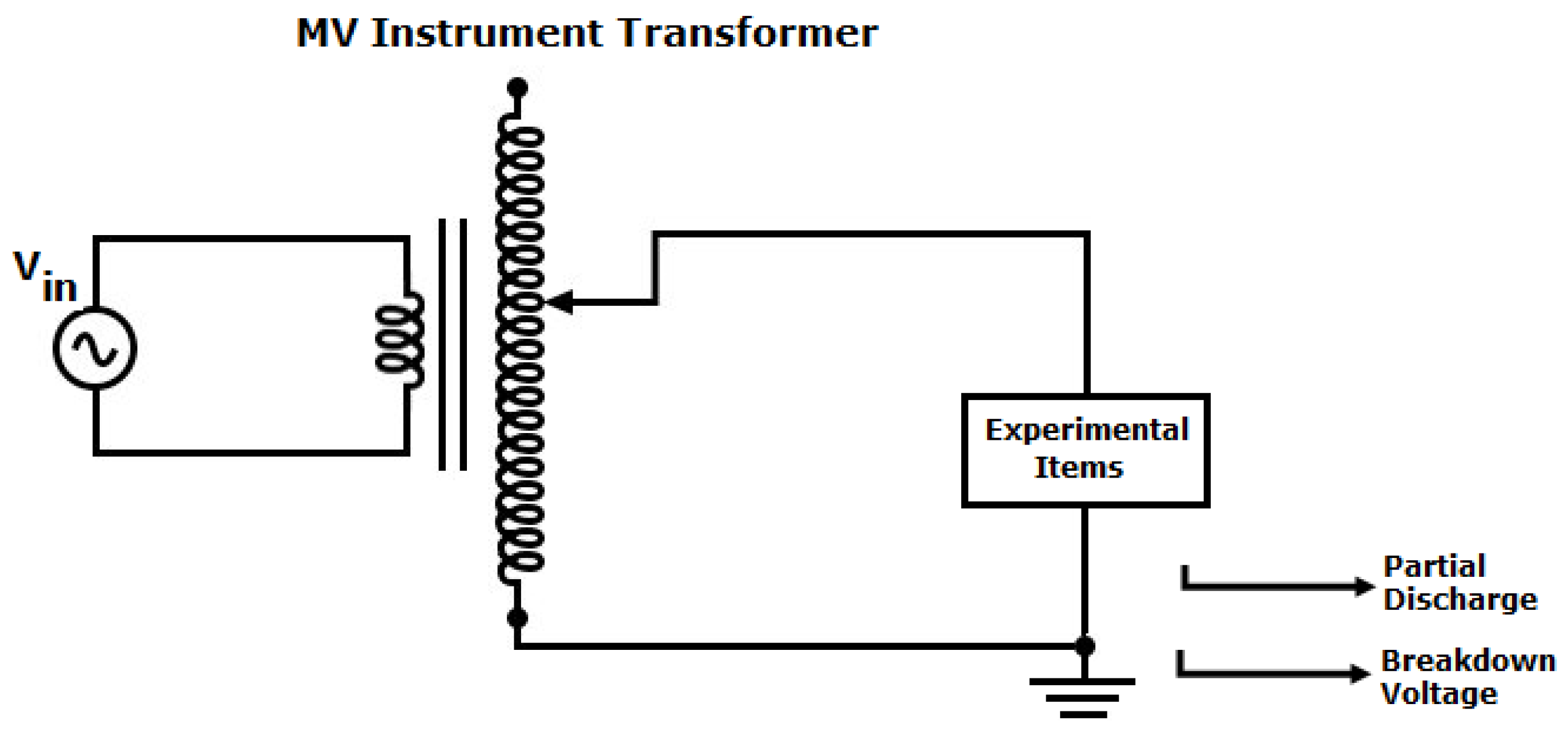
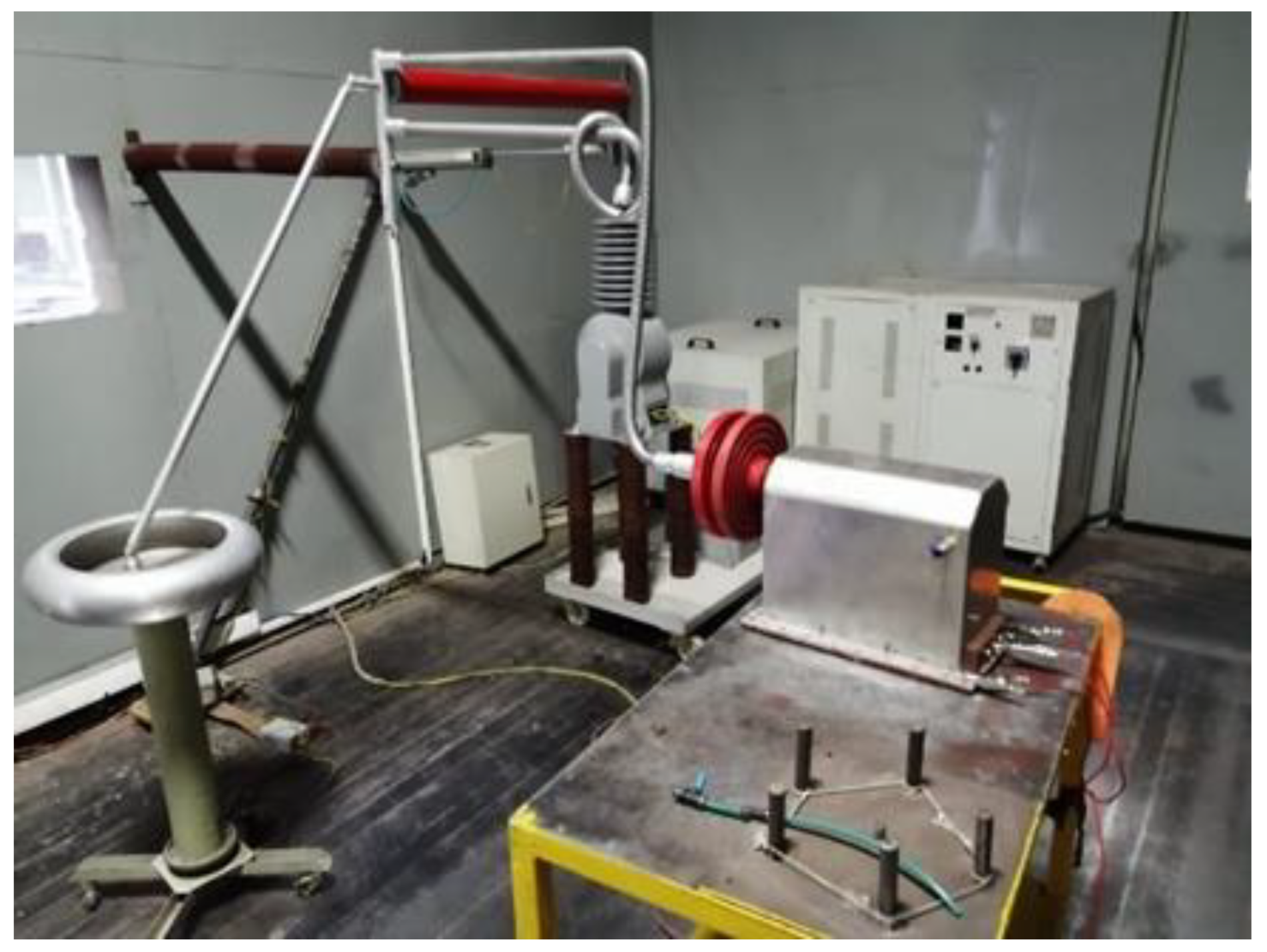
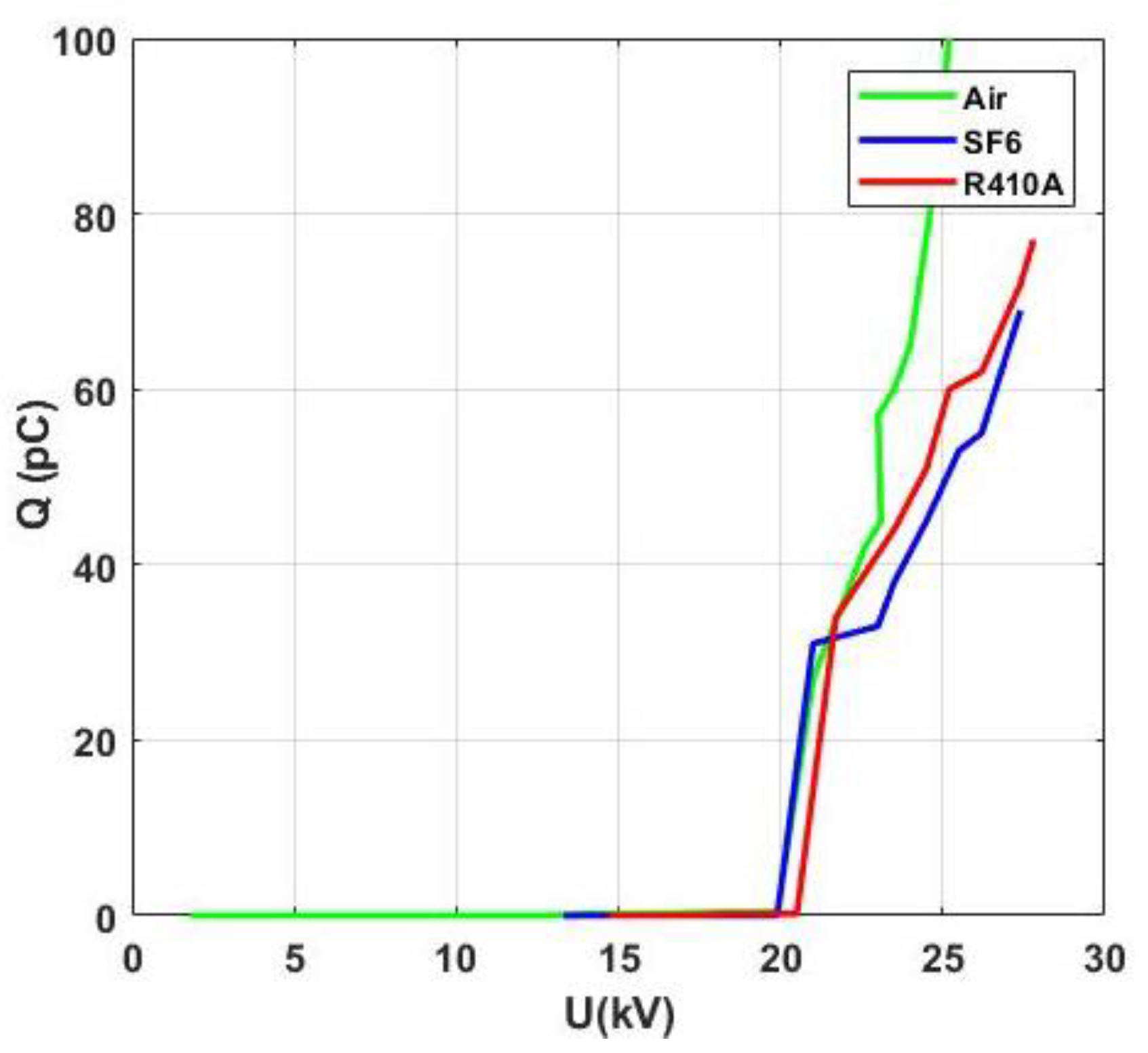
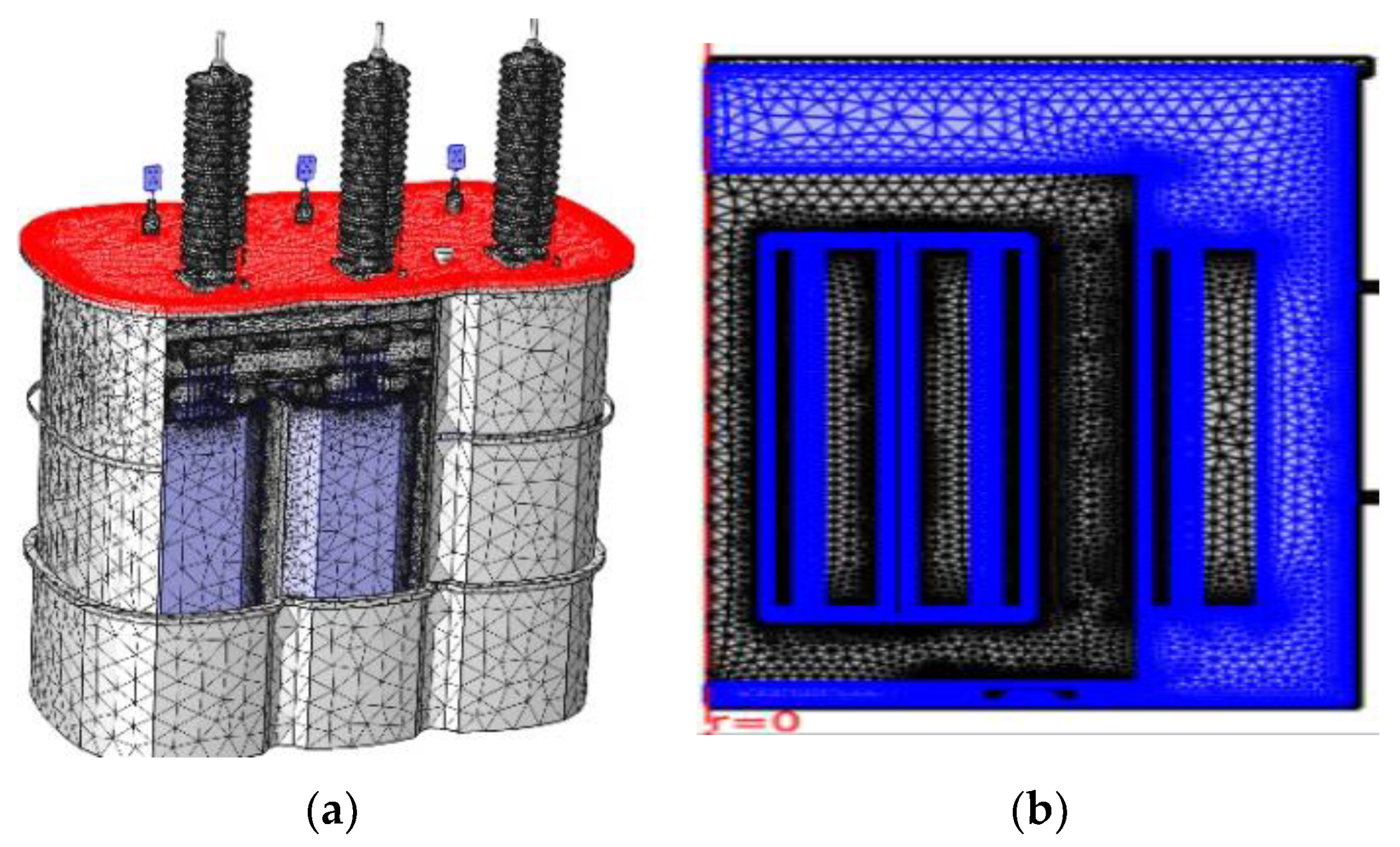
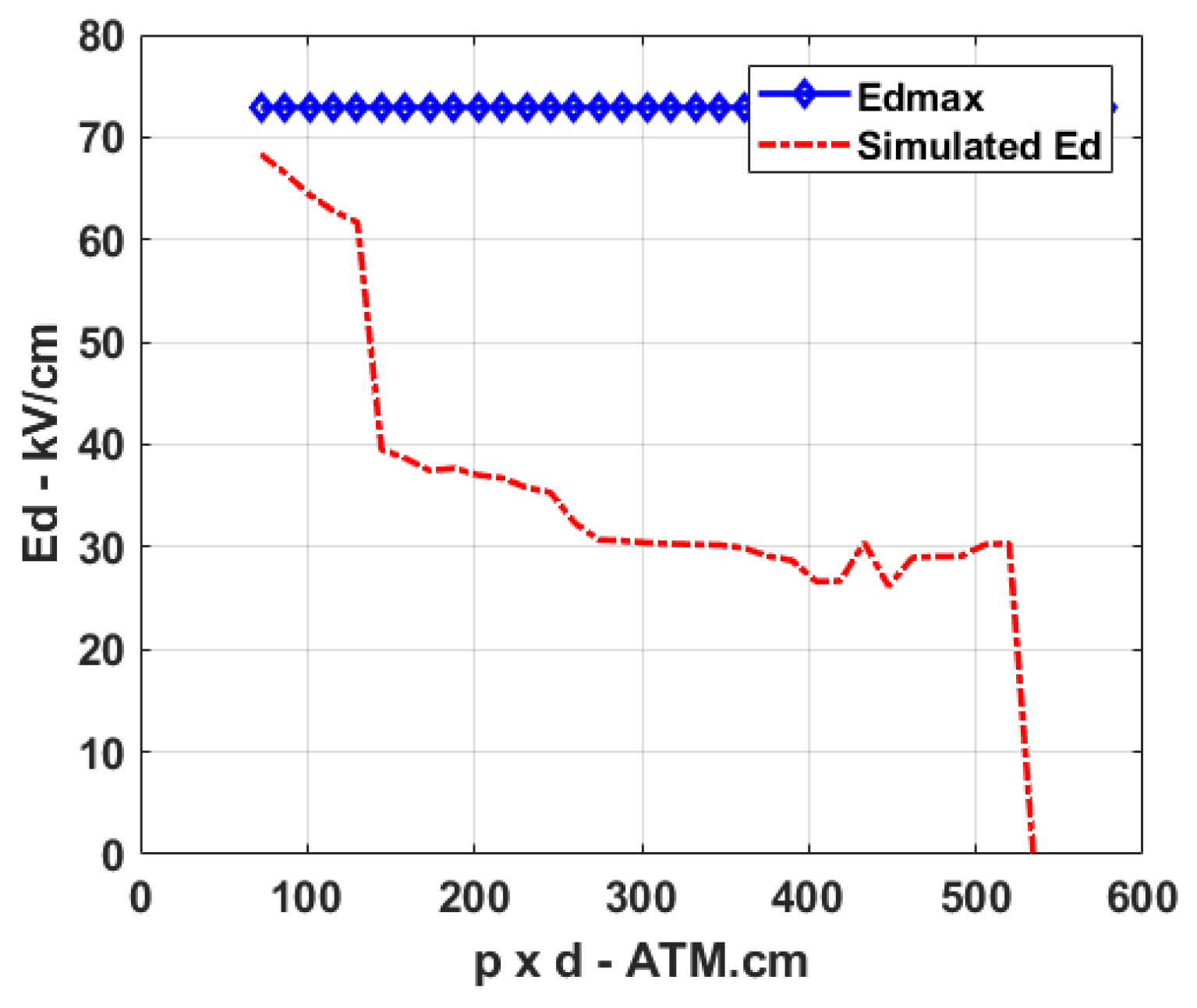
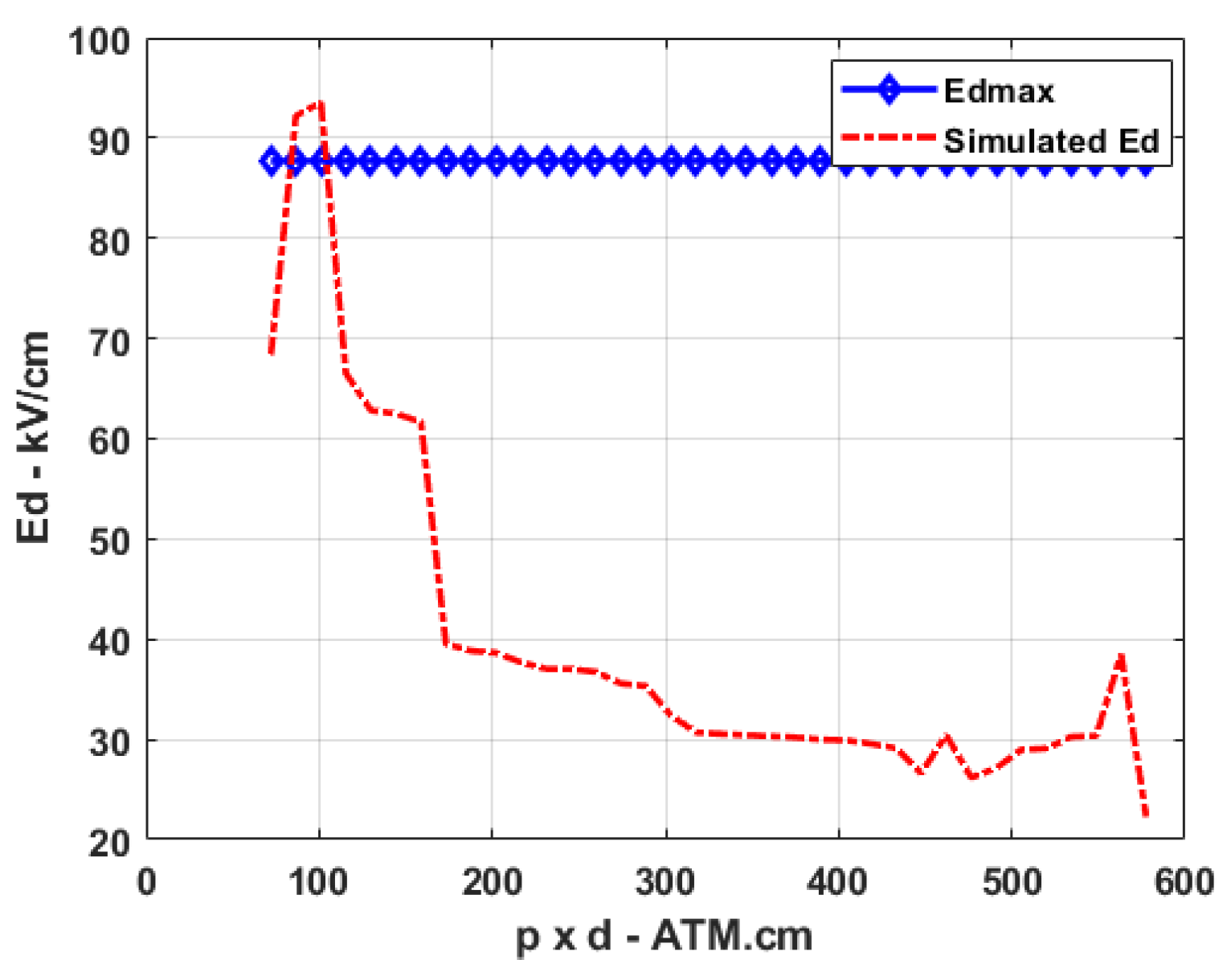
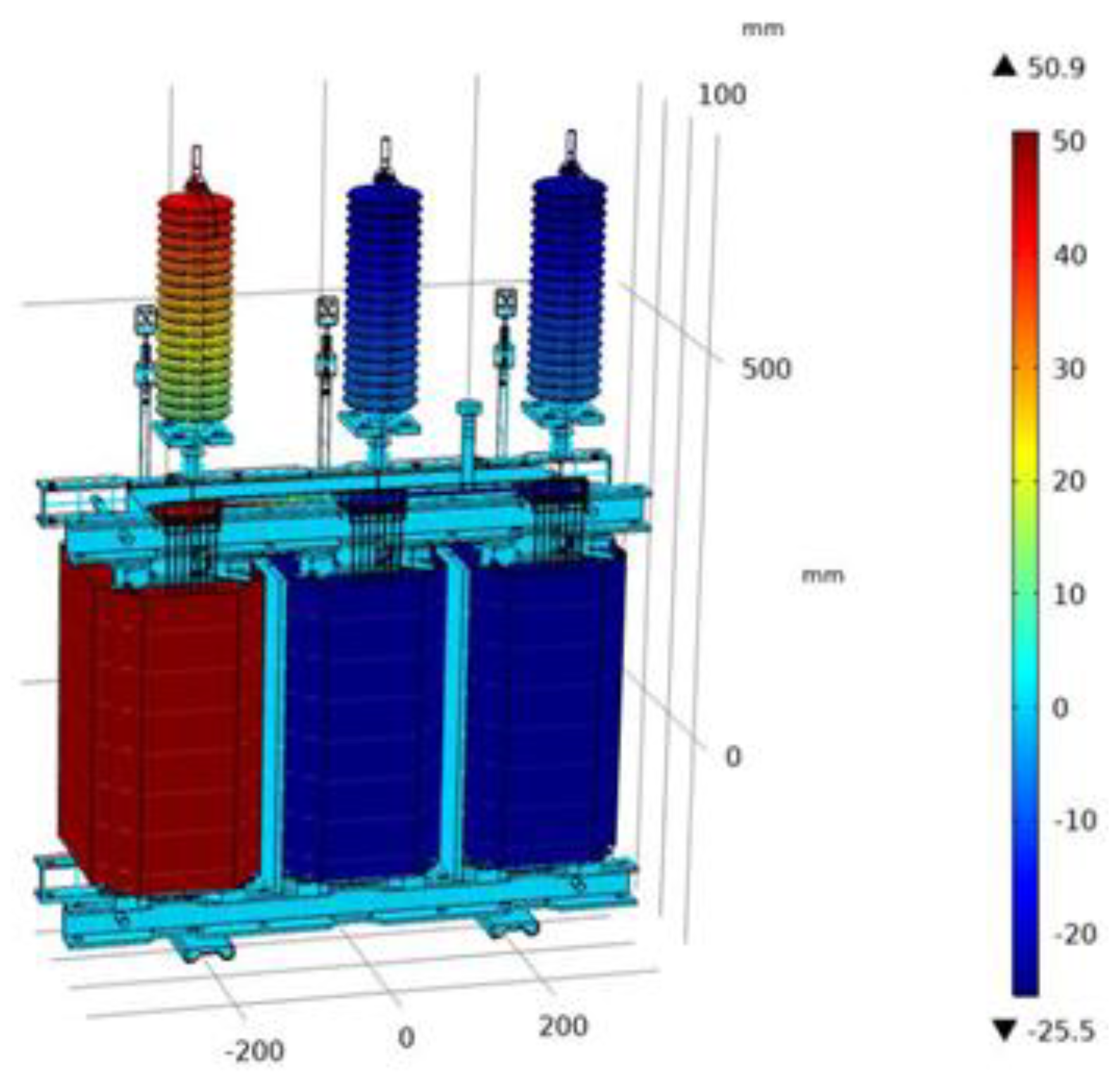

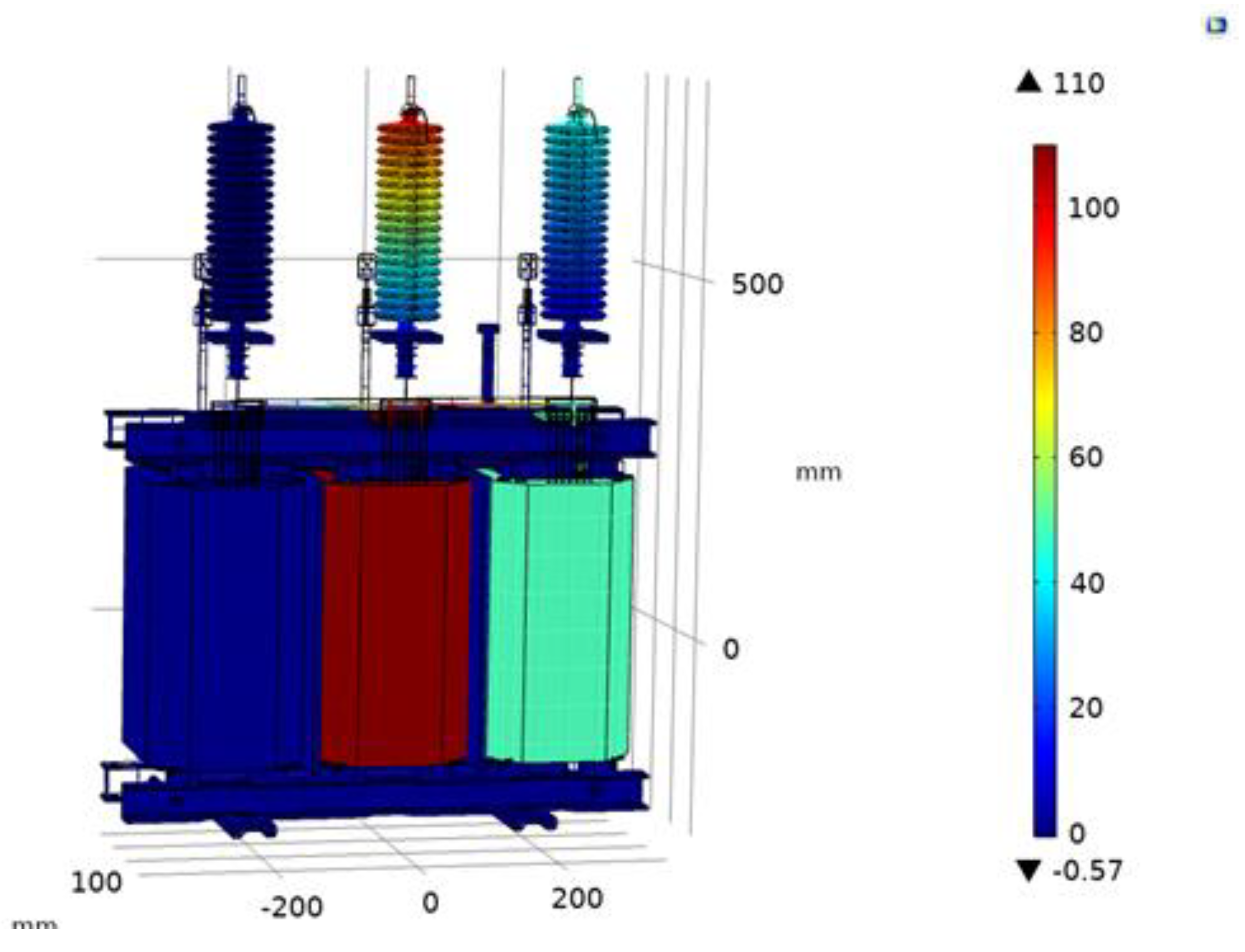
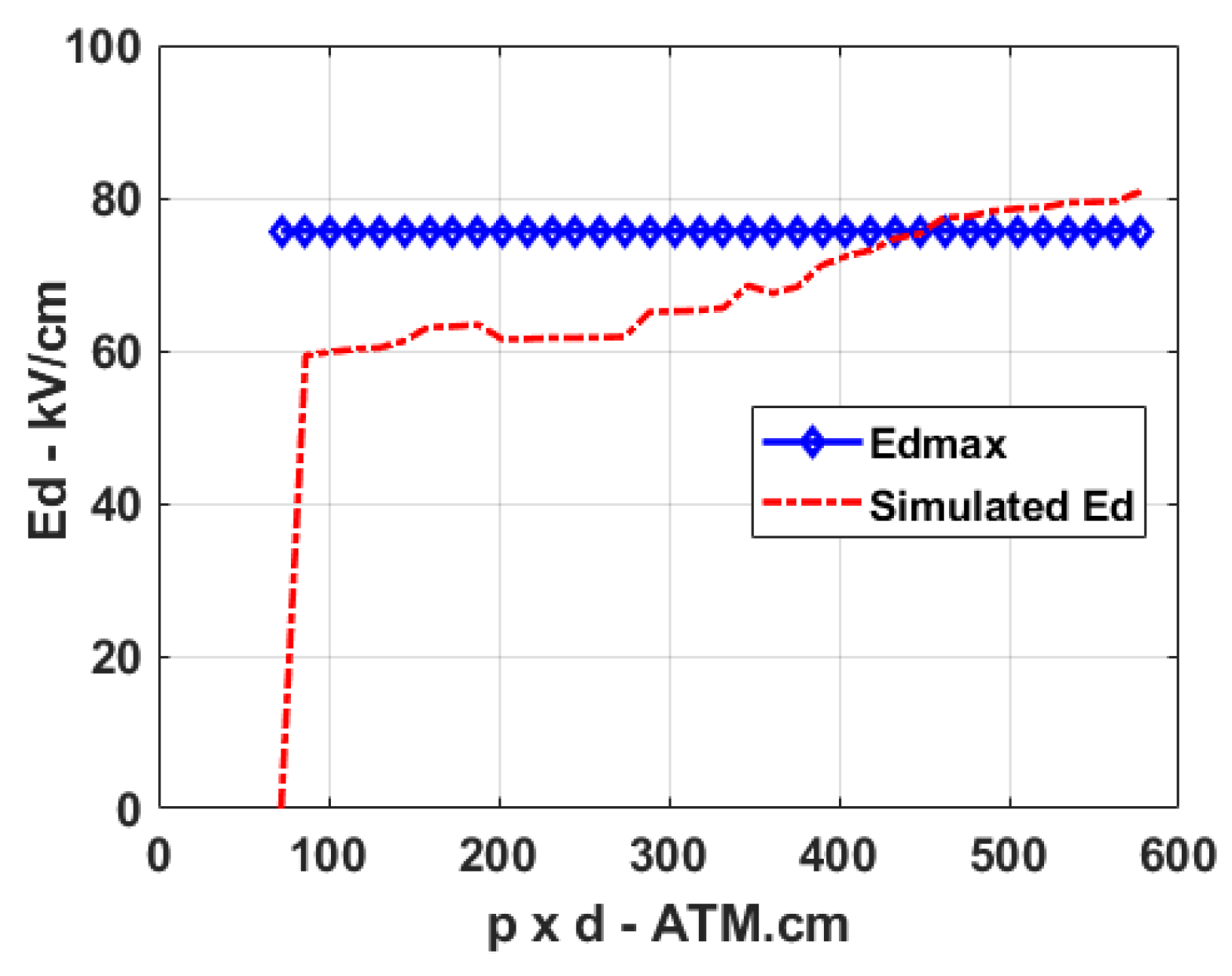
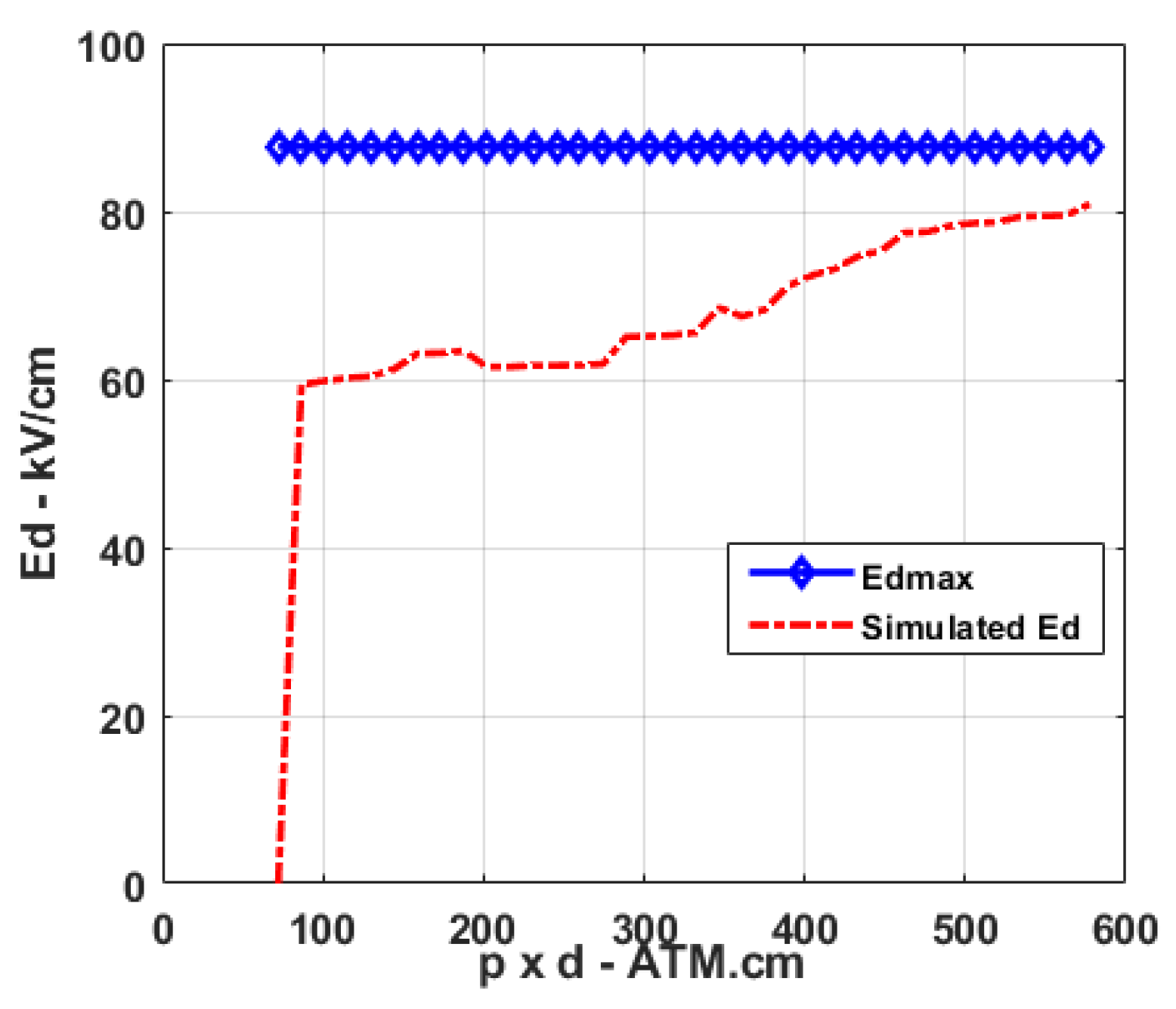
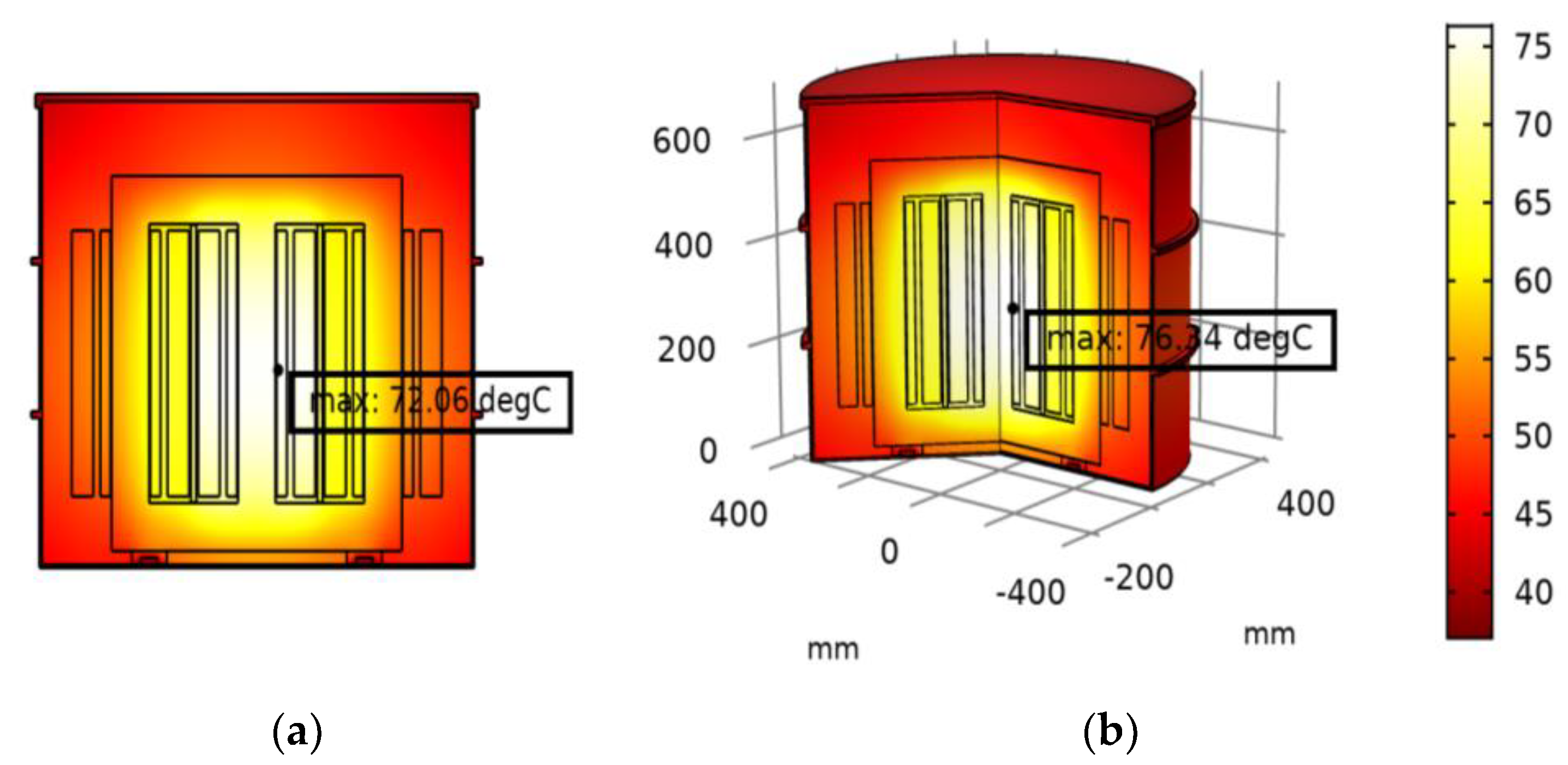
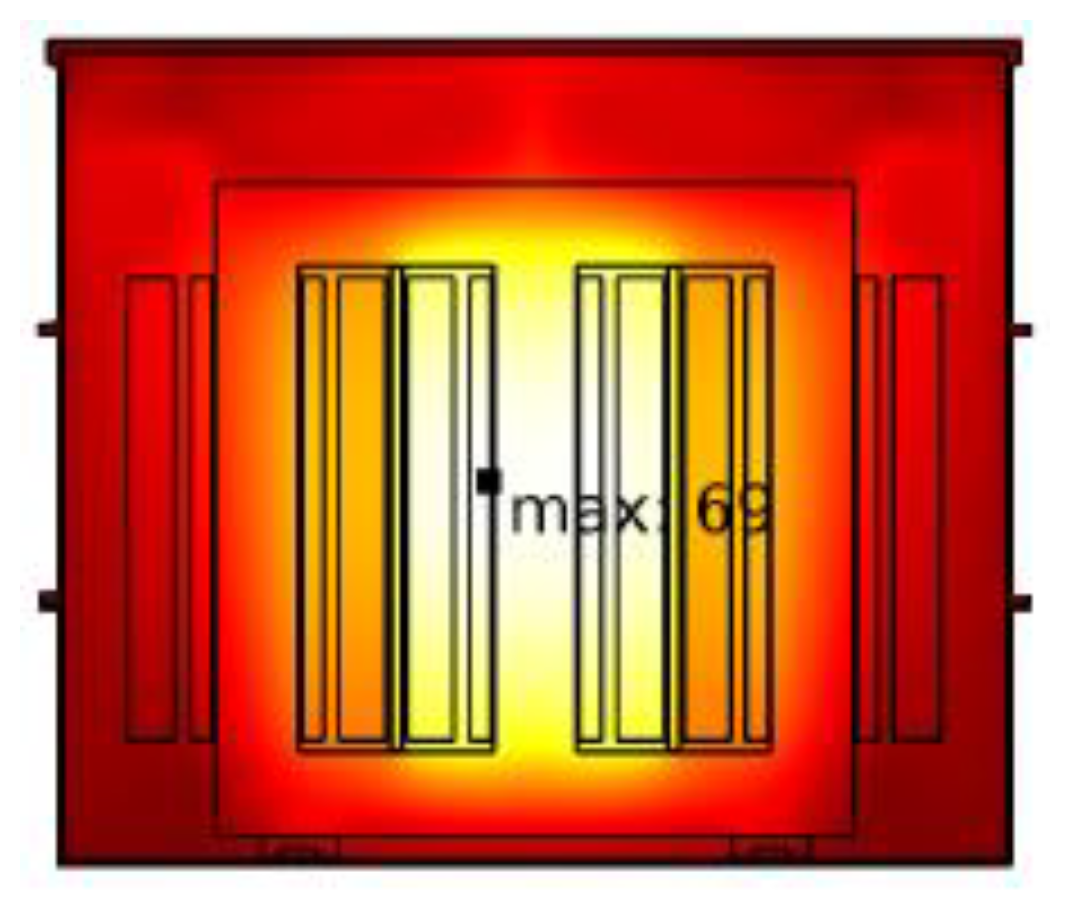

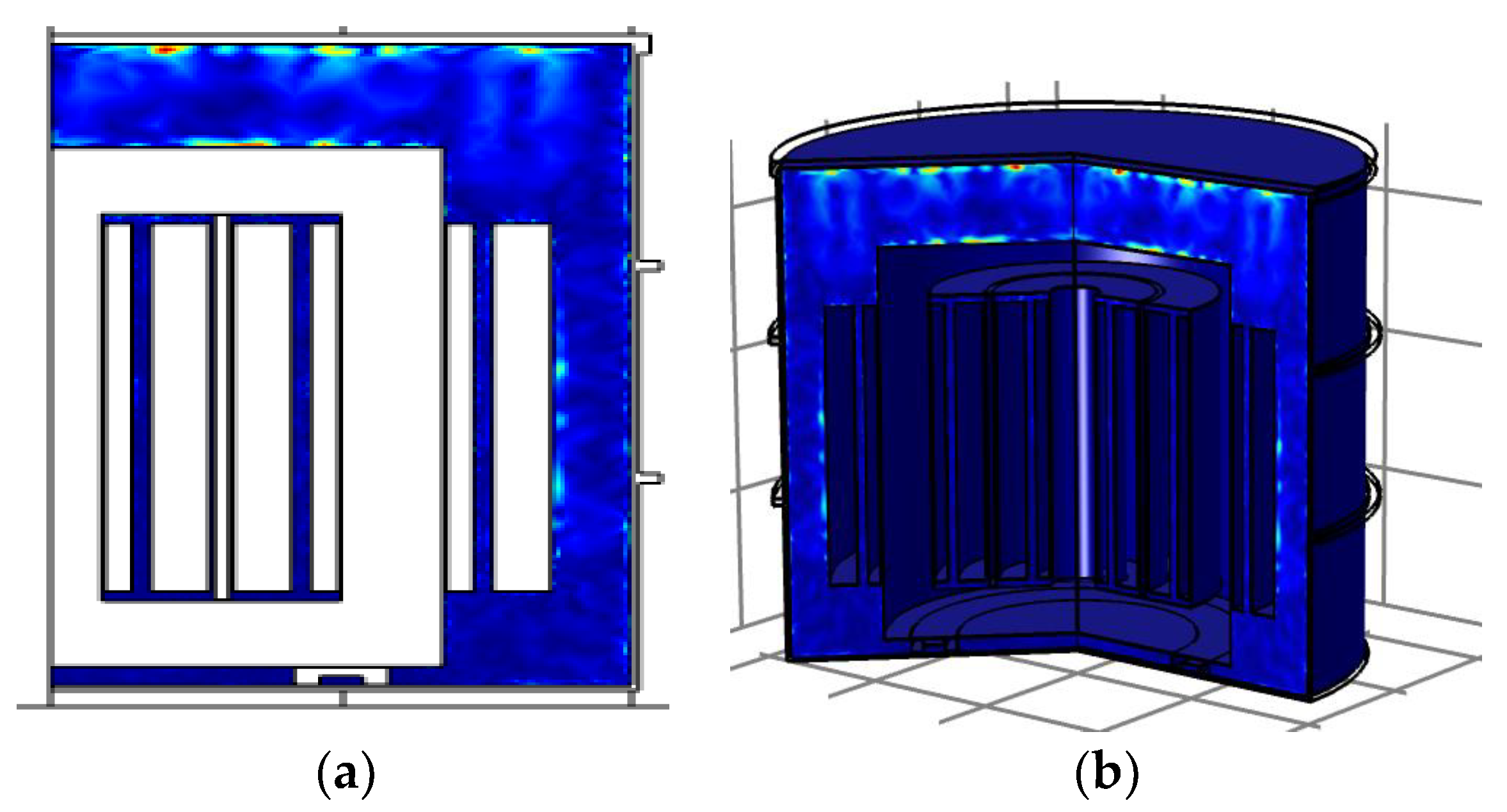
| Chemical Formula | GWP 1/100 Years | Lifetime/ Years | Dielectric Strength Relative to SF6 | Boiling Point/°C | References |
|---|---|---|---|---|---|
| SF6 | 22,800 | 850 | 1 | −64 | [17] |
| CF4 | 9200 | 50,000 | 0.4 | −128 | [17] |
| C2F6 | 12,200 | 10,000 | 0.76 | −78.1 | [17] |
| C3F8 | 8830 | 2600 | 1.01 | −36.7 | [17] |
| c-C4F8 | 8700 | 3200 | 1.3 | −8 | [17] |
| CF3I | 0.4 | 0.0055 | 1.23 | −22 | [17] |
| C5F10O | 1 | 0.044 | 1.5–2 | 27 | [17] |
| C6F12O | 1 | 0.014 | 2.7 | 49 | [17] |
| C4F7N | 2100 | 22 | 2 | −4.7 | [17] |
| R134a | 1300 | 14 | 1.014 | −26.3 | [13] |
| R410A | 1700 | 16.95 | 0.92 | −52.7 | [18] |
| Properties | SF6 | R410A | References |
|---|---|---|---|
| Chemical Formula | SF6 | CH2F2/CHF2CF3 (50/50% by weight) | [21,22] |
| Molecular Weight | 146.06 g/mol | 72.6 | [21,22] |
| Boiling Point (at 1 atm) | −63.9 °C | −51.58 °C | [21,22] |
| Vapor Pressure | 21.09 bar | 41.9 bar | [21,22] |
| Critical Temperature | 45.60 °C | 71.358 °C | [21,22] |
| Critical Pressure | 37.64 bar | 49.03 bar | [21,22] |
| Critical Density | 729 kg/m3 | 459.53 kg/m3 | [21,22] |
| Vapor Density | 6.04 kg/m3 | 4.17 kg/m3 | [21,22] |
| Specific heat of vapor (Cp) (1.013 bar ve 25 °C) | 0.609 kJ/(kg·K | 0.84 kJ/kg·K | [8,22] |
| Specific heat of liquid (Cv) (1.013 bar ve 25 °C) | 0.6689 kJ/mol·K | 1.67 kJ/kg·K | [8,22] |
| Viscosity (1.013 bar ve 0 °C) | 13.771 uPa.s | 13.85 uPa.s | [8,22] |
| Thermal Conductivity (1.013 bar ve 0 °C) | 12,058 mW/mK | 15.7 mW/mK | [8,22] |
| Global Warming Potential | 22,800 | 2000 | [21,22] |
| Ozone Depletion Potential | 0 | 0 | [21,22] |
| Atmospheric lifetime (years) | 3200 | 16.95 | [21,22] |
| Decomposition Temperature | >300 °C | >250 °C | [23,24] |
| Flammability | 0 | 0 | [21,22] |
| Toxicity | 0 | 0 | [21,22] |
| Specification | Description |
|---|---|
| Supply voltage | 220 V 50/60 Hz |
| Output voltage | 0~80 kV/100 kV |
| Accuracy | Reading ±0.2 kV |
| Switch-Off time on breakdown, ms | ≤1 ms |
| Experimental times | 1~6 for option |
| Programmed test standard | IEC 156/ASTM 877/IS-6792 |
| Specification | Description |
|---|---|
| Electrode’s configuration | Sphere–sphere |
| Distance between electrodes | 0.25 cm–1 cm |
| Electrode diameter | 36 mm |
| AC voltage | 0–100 kV AC |
| Material of electrode | brass |
| Gas pressure | 0.5 atm–2.5 atm |
| Name | Value | Description |
|---|---|---|
| h0 | 100 W/(m²·K) | heat transfer coefficient |
| power | 25,981 W | heat source in windings |
| p0 | 3.0398 × 105 Pa | initial pressure, 1.5 atm |
| rho_steel | 7500 kg/m³ | density, steel |
| rho_wood | 790 kg/m³ | density, wood |
| rho_copper | 8960 kg/m³ | density, copper |
| rho_iron | 7870 kg/m³ | density, iron |
| k_steel | 16 W/(m·K) | Thermal conductivity, steel |
| k_wood | 0.17 W/(m·K) | Thermal conductivity, wood |
| k_copper | 401 W/(m·K) | Thermal conductivity, copper |
| k_iron | 80 W/(m·K) | Thermal conductivity, iron |
| Cp_steel | 452 J/(kg·K) | heat capacity, steel |
| Cp_wood | 1674 J/(kg·K) | heat capacity, wood |
| Cp_copper | 387 J/(kg·K) | heat capacity, copper |
| Cp_iron | 450 J/(kg·K) | heat capacity, iron |
| eps_steel | 0.44 | Surface emissivity, steel |
| eps_wood | 0.95 | Surface emissivity, wood |
| eps_copper | 0.03 | Surface emissivity, copper |
| eps_iron | 0.44 | Surface emissivity, iron |
| rho_epoxy | 1200 kg/m³ | density, epoxy |
| k_epoxy | 1.66 W/(m·K) | thermal conductivity, epoxy |
| Cp_epoxy | 1000 J/(kg·K) | heat capacity, epoxy |
| eps_epoxy | 0.81 | surface emissivity, epoxy |
| rho_oil | 875 kg/m³ | density, oil |
| k_oil | 0.125 W/(m·K) | thermal Cond., oil |
| Cp_oil | 1860 J/(kg·K) | heat capacity, oil |
| eps_oil | 2.2 | surface emissivity, oil |
| gamma_oil | 3 | ratio of specific heat, oil |
| M_oil | 210 kg/mol | Molar mass, oil |
| Cp_dv | 2.2 × 10−5 m²/s | Dynamic viscosity, oil |
| eps_SF6 | 1.0204 | surface emissivity, SF6 |
| rho_SF6 | 6.2569 kg/m³ | density, SF6 |
| k_SF6 | 0.01205 W/(m·K) | thermal conductivity, SF6 |
| Cp_SF6 | 690 J/(kg·K) | heat capacity, SF6 |
| gamma_SF6 | 1.1074 | ratio of specific heat, SF6 |
| M_SF6 | 0.14606 kg/mol | Molar mass, SF6 |
| Cp_dv | 1.3771 × 10−5 Pa·s | Dynamic viscosity, SF6 |
| eps_R410A | 0.99 | surface emissivity, R410A |
| rho_R410A | 4.1742 | Density, R410A |
| k_R410A | 0.0157 W/(m·K) | thermal conductivity, R410A |
| Cp_R410A | 840 J/(kg·K) | heat capacity, R410A |
| gamma_R410A | 1.175 | ratio of specific heat, R410A |
| M_R410A | 72.6 | Molar mass, R410A |
| Cp_dv | 1.385 × 10−5 Pa·s | Dynamic viscosity, R410A |
Publisher’s Note: MDPI stays neutral with regard to jurisdictional claims in published maps and institutional affiliations. |
© 2021 by the authors. Licensee MDPI, Basel, Switzerland. This article is an open access article distributed under the terms and conditions of the Creative Commons Attribution (CC BY) license (https://creativecommons.org/licenses/by/4.0/).
Share and Cite
Guney, E.; Ozgonenel, O. An Eco-Friendly Gas Insulated Transformer Design. Energies 2021, 14, 3698. https://doi.org/10.3390/en14123698
Guney E, Ozgonenel O. An Eco-Friendly Gas Insulated Transformer Design. Energies. 2021; 14(12):3698. https://doi.org/10.3390/en14123698
Chicago/Turabian StyleGuney, Ezgi, and Okan Ozgonenel. 2021. "An Eco-Friendly Gas Insulated Transformer Design" Energies 14, no. 12: 3698. https://doi.org/10.3390/en14123698
APA StyleGuney, E., & Ozgonenel, O. (2021). An Eco-Friendly Gas Insulated Transformer Design. Energies, 14(12), 3698. https://doi.org/10.3390/en14123698







